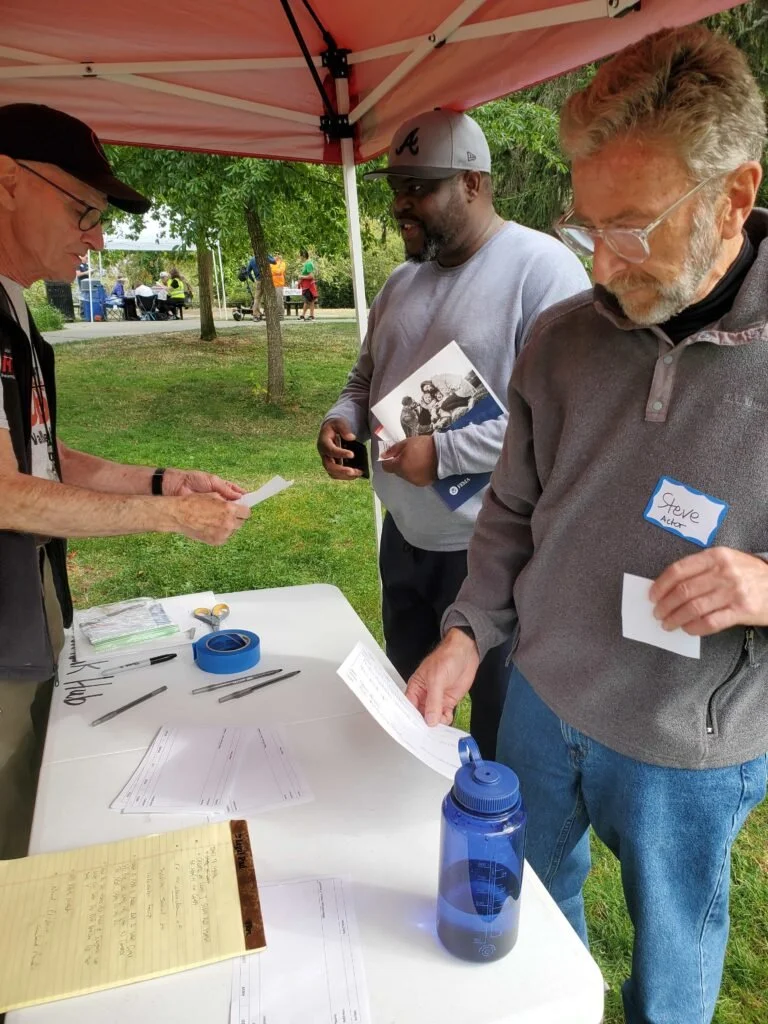
Safety Resources
Emergency Hub
Community Disaster Relief
Seattle Emergency Hub groups educate and organize people in their neighborhood about disaster preparedness for hazards that may impact their area. Volunteers and community members can assist others in their neighborhood or workplace following an event when professional responders are not immediately available to help by taking a more active role in emergency preparedness projects in their community.
The Madison Park hub site is located near the Madison Park tennis courts.
Reporting Suspicious Behavior
“We can’t stress enough the importance of reporting suspicious behavior. Sometimes, people are reluctant to call 911 about behavior that they feel is suspicious because they don’t want to “burden” police with non-emergencies. Let us assure you that calling in activity or behavior that you feel is unusual or out of place is not a burden; it’s how we know what’s going on.”
- Mark Solomon, Crime Prevention Coordinator mark.solomon@seattle.gov, 206.386.9766
-
If it’s suspicious to you, it’s worth reporting it to 911. Examples include:
• Unusual noises, including screaming, sounds of fighting, glass breaking
• People in or around buildings or areas who do not appear to be conducting legitimate business
• Unauthorized people in restricted areas
• Vehicles driving slowly and aimlessly through neighborhoods, around schools or parking lots
• People peering into parked vehicles that are not their own
• People who change their behavior when they notice that they have been seen
• People dressed inappropriately for the weather or occasion, (i.e., heavy coat in warm weather); or
• Abandoned parcels or other items in unusual locations (i.e. in a lobby or elevator) -
We urge you to call 911 when:
• You believe someone is in physical danger
• You believe a specific crime is happening
• You believe something is suspiciousWhat makes it suspicious? Be able to explain to the 911 call taker why the behavior you are seeing/hearing is suspicious. What gives you the feeling that a crime is in progress or about to occur?
-
• Where are you? Take a quick look around to make sure you know where you are. When calling 911 from a cell phone, you will be routed to the jurisdiction in which you are located. Always tell the 911 call taker exactly where you are so they can transfer you to the correct jurisdiction, if necessary. Give your specific physical address or nearest intersection; don’t assume the call taker knows.
• What just happened? Think about what you are trying to report and be ready to say, “I’m reporting a (Enter crime, emergency or suspicious activity here).”
• What information do I need to tell the call taker? Take a second to think about the people or vehicles you may need to describe -
You dial 911. The call taker answers, “911, what is your emergency/what are you reporting?”
You respond, “I’m reporting a (enter crime or emergency here).”
From this point on, let the call taker control the call and ask questions. The 911 call takers have a system and format they follow in order to get the most accurate information from you to send to the dispatchers. Allow them to follow their format and the call will go much quicker. If you interrupt the call taker by trying to give more information, you can actually slow down the police response. If a question is asked for which you do not have an answer, it’s okay to say, “I don’t know.” Please stay on the line until the call taker tells you they have what they need and says it’s okay to hang up.
Above all, stay calm. Callers often give incorrect information because they are stressed about the situation. Take a deep breath and look around. This will settle your mind, allow you to take in your surroundings, and allow you to assess any dangers related - or unrelated - to the situation.
-
The 911 call taker is focused on what you are reporting at that moment. Information the call taker may ask for includes:
What is happening?
Where is it happening?
Where are you in relation to what’s happening?
What made the person's actions suspicious?
What did the person(s)/vehicle look like?
Did the person say anything? If so, what?
Were any weapons displayed or was there threat of a weapon?
What was the person's last known location and direction of travel?
-
When giving a description of a person to the call taker, first describe things they can’t easily change:
• Race/skin tone, gender, age, hair, scars, marks, tattoos (i.e. White male, 30’s, brown hair, heart tattoo on left bicep)
Then describe their clothing from top to bottom and inside to outside:
• Blue hat, white t-shirt, black jacket, blue pants, white socks, grey tennis shoes
Describe characteristics that make the person stand out:
• Walks with a limp, no teeth, sweating profusely
Give the person’s last known location and direction of travel; where are they/which way did they go?
• Was heading north on 23rd Avenue South from South Walker Street
-
If you are reporting a suspicious vehicle – or a suspicious person in a vehicle - please provide as much information about the vehicle as you can. Consider the acronym CYMMBALS”
Color- If you don’t know, give shade (Light colored - Dark colored)
Year- If you don’t know, a rough guess works (newer - 80’s model - late 80’s)
Make- If you aren’t sure, you can say “It looked like a … (Pontiac, Hyundai, etc.).”
Model- (Grand Am, Sonata) if you don’t know, you can skip it.
Body- 2 door (Coupe), 4 door (Sedan), Hatch back, Wagon, Van.
Accessories- Roof Rack, Tinted Windows, Fancy Rims etc…
License number– if you can write it down or memorize it great. If not, relay as much as you can.
State– If the license plate is from out-of-state, please say so.
Describe anything that makes the car stand out, such as any damage and the damage location, stickers, antennae balls, etc… and last known location and direction of travel.
-
Remember that it is always better to report a person or situation and have it turn out not to be a crime or hazard than to not report and find out later that a crime was committed. You won’t get in trouble for reporting something that you feel is suspicious and upon checking it out, we discover that nothing was amiss. The important thing is to report the activity and let the responding officers sort it out.
Basic Home Security Tips
While we love to live in a place that is relatively safe, we know that crime can happen anywhere. Here are some basic home security tips that can discourage someone from targeting your property. Remember, no security measure is foolproof, but taking these steps can significantly reduce the likelihood of a break-in and provide peace of mind for you and your family.
Lock All Doors and Windows: Always lock doors and windows when you leave your home, even if you're just stepping out for a short time.
Install Deadbolt Locks: Deadbolt locks are more secure than standard locks. Install them on all exterior doors.
Use Window Locks: Make sure all windows are equipped with locks, and use them.
Reinforce Entry Points: Strengthen entry doors and frames to resist forced entry. Reinforcing strike plates and using longer screws for hinges can help.
Secure Sliding Doors: Use a bar or rod in the track of sliding glass doors to prevent them from being forced open.
Outdoor Lighting: Adequate outdoor lighting can deter criminals. Install motion-activated lights around entry points and pathways and check the bulbs on a regular cadence.
Home Security System: Invest in a home security system with monitoring services. Visible security cameras and alarm system signage can discourage burglars. Even an unmonitored system can be a serious deterrent and will provide evidence even after a crime has been committed.
Timers for Lights: Use timers to turn lights on and off when you're away to give the appearance that someone is home. Vary the schedule from day to day for longer trips.
Landscaping for Visibility: Trim bushes and trees near windows to eliminate hiding spots for potential intruders.
Secure A/C Units: If you have window or wall-mounted AC units, ensure they are properly secured to prevent them from being pushed in. Make sure the placement of the unit does not interfere with critical window locks.
Lock Sheds and Garages: These can contain valuable tools and equipment that could be used to break into your home or simply stolen.
Secure Mail and Deliveries: Don't let mail or packages pile up when you're away. Use a mailbox lock or have a neighbor collect them.
Get to Know Your Neighbors: Building a sense of community can help deter crime. Neighbors can look out for each other and report suspicious activity. Consider creating a formal Block Watch for your block.
Social Media Caution: Avoid posting vacation plans or your absence on social media platforms. This can alert potential burglars that your home is empty.
Emergency Contacts: Ensure your family knows emergency contact numbers and has a plan in case of a break-in.
Change Locks: If you move into a new home, change the locks immediately, as you can't be certain who might have keys from the previous owner.
Home Security Evaluation: Consider hiring a professional to assess your home's security vulnerabilities and suggest improvements.
Find It, Fix It App
"Find It, Fix It" is a smartphone app offering mobile users one more way to report selected issues to the City of Seattle. Things like abandoned cars, clogged storm drains, overgrown vegetation, graffiti, street sign maintenance, dead animals, and more. Click here for a full list of reasons to use this app.
With Find It, Fix It, reporting an issue is as easy as snapping a photo with your smartphone, adding detailed information, and hitting submit. The map's "drag and drop" feature or the phone's own technology can be used to pinpoint the location.
Android users can download the app from the Google Play Store and iPhone users can download it from the App Store
City of Seattle Resources:
For emergencies, sharing information about people who need help, or to report disturbances of any kind please call 911.
Calling 911 is important to get problems logged into the police system. If we don’t call, we will not alert the city to problems in our area. If you are put on hold or do not get a response, reach out to Victoria Beach, Seattle Police Public Safety Liaison, her direct information is below.
Crime Prevention Services and Resources:
https://seattle.gov/police/crime-prevention
City of Seattle Attorney’s Office:
(crime news and victim assistance)
https://www.seattle.gov/cityattorney
Starting a Block Watch:
To understand the current city-endorsed and supported process of starting and maintaining a Block Watch, please visit:
https://seattle.gov/police/crime-prevention/block-watch
Seattle Non-Emergency Number: 206-625-5011
Victoria Beach, Seattle Police Public Safety Liaison:
Direct: 206.470.9869
victoria.beach@seattle.gov
Dominique Stephens
Public Safety Initiatives Liaison Office of Mayor Bruce Harrell
O: 206-473-8682
Dominique.Stephens@Seattle.gov
600 Fourth Ave, 7th Floor, Seattle, WA 98104
Mail: P.O. Box 94749, Seattle, WA 98124
Joseph Elenbaas #8174
Crime Prevention Coordinator Community Outreach
T: 206 684-5758
C: 206 247-2831
joseph.elenbaas@seattle.gov
East Precinct 1519 12th Ave, Seattle, WA 98122-3907
Captain Michael Tietjen
East Precinct Police Captain
C: 206-484-0198
michael.tietjen@seattle.gov
East Precinct 1519 12th Ave, Seattle, WA 98122-3907




